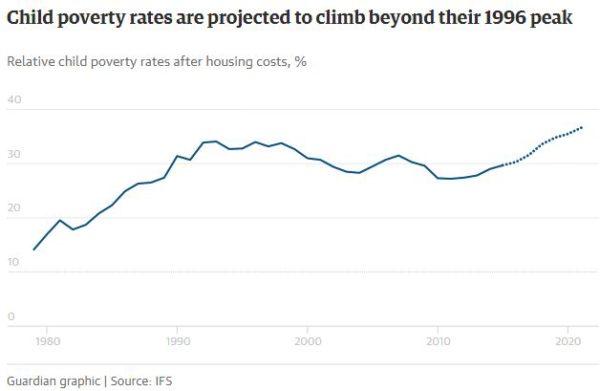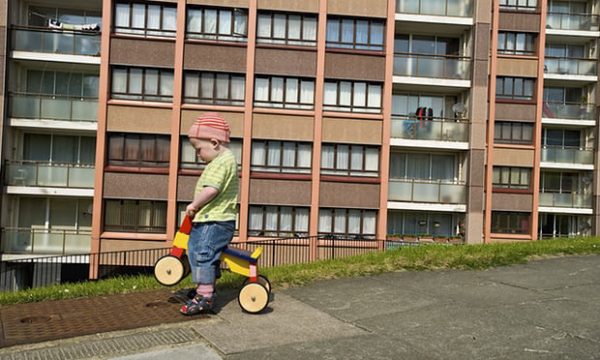Child poverty in Britain set to soar to new record, says thinktank
November 10, 2017 · By Larry Elliott for www.theguardian.com
IFS forecast that 37% of children will be in relative poverty by 2022 would see all progress made in the last 20 years undone

A young girl walking through a housing estate in Skelmersdale, Lancashire. Photograph: Alamy
The number of children living in poverty will soar to a record 5.2 million over the next five years as government welfare cuts bite deepest on households with young families, a leading UK thinktank has said.
New research from the Institute for Fiscal Studies predicts an increase of more than a million in the number of children living in poverty, more than reversing all the progress made over the past 20 years.
The IFS said freezing benefits, the introduction of universal credit and less generous tax credits would mean a surge in child poverty and that the steepest increases would be in the most deprived parts of the country.
“Across all regions, relative child poverty is projected to increase markedly,” the IFS said. “The smallest increases are in the south, but even there relative child poverty is projected to rise by at least four percentage points. The northern regions, the Midlands, Wales and Northern Ireland are projected to see increases of at least eight percentage points.”
The report’s findings, which also predict a widening of the gap between rich and poor and four more years of weak income growth, pose a direct challenge to Theresa May, who arrived in Downing Street pledging to help those “just about managing”.

May has slightly softened the impact of the £12bn of welfare cuts announced by the then chancellor George Osborne after the 2015 general election, but the IFS said the impact on poor families would still be severe.
By 2021-22, the IFS expects 37% of children to be living in relative poverty – defined as a household where the income is less than 60% of the UK median – after housing costs have been taken into account. The thinktank said this was the highest percentage since modern records began in 1961.
Tackling child poverty was a priority for Labour when it took office in 1997 and over the next 13 years the rate fell from 34% to just under 30%. Since then, the relative child poverty rate has remained unchanged but, according to the IFS, is now set to increase by seven percentage points to 37% over the next five years.
The IFS added that relative child poverty would be higher by the early 2020s than it was before the recession of 2008-09 in every region of the country, but that 40% of the projected increase would be concentrated in the most deprived 20% of local areas.
Tom Waters, an author of the report and a research economist at the IFS, said: “Every region and nation is projected to see an increase in child poverty, with the largest increases in the north-east, east Midlands, Wales, and Northern Ireland, and the smallest in London, the south-east, and south-west.
“The larger projected rises occur in areas where families with children are more reliant on benefits than earnings for their income, and where more families are likely to be adversely affected by the new two-child limit on means-tested benefits.”
A government spokesperson said: “We are committed to supporting families while making the welfare system fair for those who pay for it and those who benefit from it. There are 200,000 fewer children living in poverty than in 2010 and we are helping families keep more of what they earn by cutting taxes and increasing the National Living Wage. In particular, the north-east has near-record levels of employment, and unemployment rate in Wales is the lowest on record.”
The IFS said the increase in relative poverty over the coming years would be concentrated among families with children. Poverty rates for working-age adults without children and for pensioners would remain roughly unchanged.

A boy playing in Whitehawk housing estate, Brighton. Photograph: Photofusion/REX/Shutterstock
Living standards would continued to be under pressure over the coming years, the thinktank added, noting that the weakness in income growth since the recession had been unprecedented in recent times.
Median income growth had slowed from its historical average of 2% a year to 0.5% between 2007 and 2015, and was projected to increase by 0.8% a year in the period up to 2021, the report said. A decade and a half of weak growth meant median incomes in 2012 were on course to be 20% lower by the end of the current parliament in 2022 they would have been had the pre-recession trend continued.
Andrew Hood, an author of the report and a senior research economist at the IFS, said: “Growth in average household incomes over the next few years is likely to be sluggish at best. If workers’ earnings grow as the OBR [Office for Budget Responsibility] expected back at the March budget, median income is projected to rise by just 4% over the next four years – about half as fast as was normal before the financial crisis. But given that the OBR have already indicated they now think that forecast was too optimistic, the true picture could be even worse.”
Income inequality narrowed between 2007 and 2015 because the squeeze on earnings growth hit those on higher incomes hardest while working-age benefits remained “essentially unchanged”, the IFS said.
It added, however, that this trend would be reversed over the next few years, “with real earnings growth boosting the incomes of those at the top of the distribution more, while benefit cuts fall largely on those nearer the bottom”.






